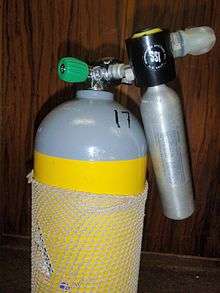Bailout bottle
 Filling a spare air bailout cylinder | |
| Other names | Bailout cylinder, emergency gas supply |
|---|---|
| Uses | Emergency supply of breathing gas |
| Related items | Pony bottle |
A bailout bottle or bailout cylinder is a scuba cylinder carried by an underwater diver for use as an emergency supply of breathing gas in the event of a primary gas supply failure. A bailout cylinder may be carried by a scuba diver in addition to the primary scuba set, or by a surface supplied diver using either free-flow or demand systems.[1] The bailout gas is not intended for use during the dive except in an emergency. The term may be used to refer to just the cylinder, or the bailout set or emergency gas supply (EGS), which is the cylinder with the gas delivery system attached.
In solo diving, a buddy bottle is a bailout cylinder carried as a substitute for an emergency gas supply from a diving buddy.
Bailout cylinders for use with scuba
For scuba, a "bailout bottle" or "self-contained ascent bottle" is a small diving cylinder meant to be used as an alternate air source to allow a controlled ascent with any required decompression, in place of a controlled emergency swimming ascent, which will not allow required decompression. A bailout cylinder is required equipment for a professional diver using scuba in some circumstances.[2]
Types
A pony bottle is an example of a small bailout cylinder which has a standard diving regulator with first and second stages. There are also significantly smaller cylinders which have the first stage — and in the smallest models also the second stage — integrated into the cylinder valve itself.[3] A well-known example of this class of bailout bottle is the "Spare Air" set, which can supply a few breaths to allow the diver to ascend at a safe rate, but not enough to do a decompression stop. This type of bailout bottle is typically carried in a holster that is attached to the diver's harness.[4]
"Spare Air" bailout bottles, introduced in the 1980s, are very small cylinders with integral scuba regulators. Their disadvantage is that in many emergency situations they do not have sufficient capacity to get a diver back to the surface safely, and thus may cause divers carrying them to feel an unjustified sense of safety. Their advantage is that they are compact and easy to deploy, and that a small amount of air is better than none in an emergency.[4]
Capacity
A review carried out by Scuba Diving magazine attempted to give a sense of from what depth bailout bottles of various capacities could get divers to the surface under maximum safe ascent rates, though the review cautioned that the reviewers were in controlled conditions and thus could not replicate the circumstances of an actual panicked diver. The review found that a 1.7-cubic-foot (0.24 L) bottle had sufficient air to get the reviewing diver from 45 feet (14 m) to the surface; a 3-cubic-foot (0.4 L) bottle from a depth of 70 feet (21 m); and a 6-cubic-foot (0.8 L) bottle from the maximum reviewed depth of 132 feet (40 m), which is the maximum depth recommended for recreational dives by some training agencies.[4]
Mounting arrangements

A bailout cylinder is defined by its function, and may be carried in any convenient way. The small "Spare Air" type is commonly carried in a pocket type holster which is strapped to the harness where it can easily be reached, usually somewhere on the front of a jacket style buoyancy compensator. Larger bailout cylinders may be strapped to the back cylinder, (see Pony bottle), or suspended from the harness D-rings along the side of the diver as a side-mount, or sling cylinder.
Bailout cylinders for use with surface supplied equipment
For commercial diving using surface supplied breathing gas, the bailout cylinder is in many cases required by health and safety legislation[5] and approved codes of practice[6] as an obligatory component of the diving system. In this application the intention is that the bailout cylinder should hold sufficient breathing gas for the diver to be able to reach a place of safety where more breathing gas is available, such as the surface or a diving bell. To achieve this the cylinder must contain enough gas to allow decompression if that is included in the planned dive profile and there is no bell. Cylinder volumes are generally at least 7 litres, and may in some cases be as much as twin 12-litre sets.
See also
References
- ↑ Larn, Richard; Whistler, Rex (1993). Commercial Diving Manual (3rd ed.). Newton Abbott, UK: David and Charles. ISBN 0-7153-0100-4.
- ↑ Sheldrake, S; Pedersen, R; Schulze, C; Donohue, S; Humphrey, A (2011). "Use of Tethered Scuba for Scientific Diving". In: Pollock NW, ed. Diving for Science 2011. Proceedings of the American Academy of Underwater Sciences 30th Symposium. Retrieved 2016-01-09.
- ↑ "Bailout Bottle". scuba-info.com. Retrieved 28 April 2010.
- 1 2 3 "Bailout Bottles". Scuba Diving. Bonnier Corporation. October 18, 2006. Retrieved 28 April 2010. – Publishers of Scuba Diving magazine.
- ↑ "Diving Regulations 2009". Occupational Health and Safety Act 85 of 1993 – Regulations and Notices – Government Notice R41. Pretoria: Government Printer. Retrieved 3 November 2016 – via Southern African Legal Information Institute.
- ↑ Staff (February 2014). IMCA D014 International Code of Practice for Offshore Diving (PDF) (Revision 2 ed.). London, UK: International Marine Contractors Association. Retrieved 30 January 2016.
%2C_is_fitted_with_a_Kirby_Morgan_37_Dive_Helmet.jpg)